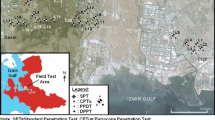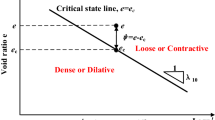Abstract
Many places in the world are heavily contaminated with landmines, which cause that many resources are not utilized. This makes landmine detection and removal challenges for research. To guarantee reliable landmine sensing system, deep analysis and many test cases are required. The proposed concept is based on application of 1 kPa external constant pressure (lower than the landmine activation pressure) to the sand surface. The resultant contact pressure distribution is dependent on the imbedded object characteristics (type and depth). Then neural networks (NN) are trained to find the inverse solution of the sand–landmine problem. In other words, when the contact pressure is known, NN can estimate the imbedded object type and depth. In this work, using finite element modeling, the existence of landmines in sand is modeled and analyzed. The resultant contact pressure distribution for five objects (1—anti-tank, 2—anti-personnel, 3—can with diameter and height of 200 mm, 4—spherical rock with 200 mm diameter, and 5—sand without any object) in sand at different depths is used in training NN. Three NN are developed to estimate the landmine characteristics. The first one is perceptron type which classifies the introduced objects in sand. The other two feed-forward NN (FFNN) are developed to estimate the depth of two landmine types. The NN detection rates of anti-tank and anti-personnel landmines are 100 and 67 % in training, and 95 and 70 % in validation, respectively. As test cases, the detection rates of the NN in case of landmine inclination angles (0°–30°) are studied. The results show same detection rates as those at no inclination. A random noise 10 % of the average signal does not affect NN detection rates, which are the same as 95 and 70 % as in validation for anti-tank and anti-personnel, respectively, while with 20 % noise detection rates are decreases to 90 and 50 % for anti-tank and anti-personnel, respectively.















Similar content being viewed by others
References
Megahed SM, Ali HFM, Hussein AH (2010) Egypt landmine problem: history, facts, difficulties and clearance efforts. In: International symposium humanitarian demining 2010, Šibenik, Croatia
Furuta K, Ishikawa J (eds) (2009) Anti personnel landmine detection for humanitarian demining. Springer, ISBN: 978-1-84882-346-4
Detectors and Personal Protective Equipment Catalogue 2009 (2009) GICHD: Geneva International Centre for Humanitarian Demining, Geneva, January 2009
Macdonald J, Lockwood JR, Mcfee J, Altshuler T, Broach T, Carin L, Harmon R, Rappaport C, Scott W, Weaber R (2003) Alternatives for landmine detection. RAND, Pittsburg
Habib M (2008) Humanitarian demining innovative solutions and the challenges of technology. I-Tech Education and Publishing
Ali HFM (2011) Master thesis: Requirements and design constraints of a demining robot prototype with its kinematic modeling, simulation and experimentation. M.Sc. Thesis, Cairo University, 2011
Dawson-Howe KM, Williams TG (1998) The detection of buried landmines using probing robots. Robot Auton Syst 23(4):235–243
Furihata N, Hirose S (2005) Development of mine hands: extended prodder for protected demining operation. Auton Robots 18(3):337–350
Megahed SM, Ali HFM (2012) Remotely operated robots with application to landmines removal in Egypt. In: 43rd International symposium on robotics (ISR2012), Taipei, Taiwan, 29–31 Aug 2012
Baglio S, Cantelli L, Costantino C, Giusa F, Muscato G (2013) A survey on instrumented prodding techniques for landmine recognition. In: Proceedings 10th international symposium on humanitarian demining coupled (IARP WS HUDEM), Šibenik, Croatia
Schröder CT, Scott WR Jr (2000) A finite-difference model to study the elastic-wave interactions with buried land mines. IEEE Trans Geosci Remote Sens 38(4):1505–1512
Scott WR Jr, Martin JS, Larson GD (2001) Experimental model for a seismic landmine detection system. IEEE Trans Geosci Remote Sens 39(6):1155–1164
Martin JS, Larson GD, Scott WR Jr (2005) Surface-contacting vibrometers for seismic landmine detection. In: Proceedings of SPIE, vol 5794. SPIE, Bellingham. doi:10.1117/12.603923
Ishikawa J, Iino A (2010) A study on prodding detection of antipersonnel landmine using active sensing prodder. In: International symposium: humanitarian demining 2010, Šibenik, Croatia
Baglio S, Muscato G, Savalli N (2002) Tactile measuring systems for the recognition of unknown surfaces. IEEE Trans Instrum Meas 51(3):522–531
Baglio S, Cantelli L, Giusa F, Muscato G, Noto A (2014) A novel smart prodder with sensor feedback for material recognition in humanitarian demining applications. In: Proceedings IEEE sensors, pp 779–782, Valencia, Spain
Baglio S, Cantelli L, Giusa F, Muscato G (2015) Intelligent prodder: implementation of measurement methodologies for material recognition and classification with humanitarian demining applications. IEEE Trans Instrum Meas 64(8):2217–2226. doi:10.1109/TIM.2014.2386917
Pennec F, Achkar H, Peyrou D, Plana R, Pons P, Courtade F (2007) Verification of contact modeling with comsol multiphysics software. Rapport LAAS n07604. <hal-00180257>
Comsol Multiphysics (1994–2008) Structural mechanics module verification manual © Copyright 1994–2008 By Comsol
Matriche Y, Feliachi M, Zaoui A, Abdellah Mehdi (2013) An EMI inversing problem for landmine characterization based on improved particle swarm optimization and finite element analysis. Prog Electromagn Res B 49:411–428
Zyada Z, Matsuno T, Fukuda T (2008) Fuzzy template based automatic landmine detection from GPR data. In: The 7th IARP international WS HUDEM’2008, AUC, Cairo, 28–30 Mar 2008
Nishimoto M, Nagayoshi K, Ueno S, Kimura Y (2007) Classification of landmine-like objects buried under rough ground surfaces using a ground penetrating radar. IEICE Trans Electron E90-C(2):327–333
Moustafa K, Hussein KFA (2007) Aperture sensor GPR system for land mine detection. Prog Electromagn Res 72:21–37
Ali HFM, Zyada Z, Fath El Bab AMR, Megahed SM (2015) Inclination angle effect on landmine detection estimation in sandy desert using neural networks. In: The 10th Asian control conference, IEEE (ASCC 2015). doi:10.1109/ASCC.2015.7244615
Jaeger Platoon Website (2015) http://www.jaegerplatoon.net/landmines2.htm. Last checked March 2015
Absolute Astronomy Website (2015) http://www.absoluteastronomy.com/topics/List_of_landmines. Last checked March 2015
Kamat HV, Rao DH (1995) Direct adaptive control of non-linear systems using a dynamic neural network. IEEE Trans Autom Control 39:987–991
Acknowledgments
This research is funded by the Egypt-Japan University of Science and Technology (EJUST), Alexandria, Egypt.
Author information
Authors and Affiliations
Corresponding author
Rights and permissions
About this article
Cite this article
Ali, H.F.M., Fath El-Bab, A.M.R., Zyada, Z. et al. Estimation of landmine characteristics in sandy desert using neural networks. Neural Comput & Applic 28, 1801–1815 (2017). https://doi.org/10.1007/s00521-015-2153-z
Received:
Accepted:
Published:
Issue Date:
DOI: https://doi.org/10.1007/s00521-015-2153-z




